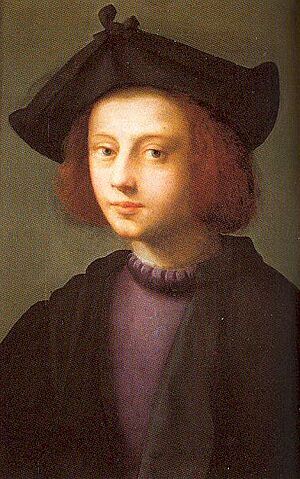Pietro Carnesecchi facts for kids
Pietro Carnesecchi (born December 24, 1508 – died October 1, 1567) was an important Italian thinker during the Renaissance. He was known for his interest in new ideas and his friendships with many influential people of his time.
Contents
Pietro Carnesecchi: A Renaissance Thinker
Early Life and Education
Pietro Carnesecchi was born in Florence, Italy. His father, Andrea Carnesecchi, was a successful merchant. Andrea became very important in the papal court, which is like the government of the Pope, thanks to the help of the Medici family. One of the Medici family members, Giulio de' Medici, later became Pope Clement VII.
Pietro learned about new ways of thinking and studying, often called the "new learning," at the home of his uncle, Cardinal Bernardo Dovizi, in Rome. By the time he was 25, Pietro held several important jobs in the Church. He worked as a notary and a protonotary for the Roman Curia, which handles the Pope's administration. He also became the Pope's first secretary. In this role, he managed important letters and tasks, including communicating with the Pope's representatives in other countries.
New Ideas and Friendships
Pietro Carnesecchi traveled to Marseille and met Francis I of France. He impressed the French court, including Catherine de' Medici, who would later become Queen of France. These connections helped him in the future.
In Rome, he met Juan de Valdés, a Spanish reformer. Pietro later got to know Valdés better in Naples, where Valdés was a theologian, someone who studies religion. Pietro was especially drawn to Valdés's ideas because of their shared friend, Bernardino Ochino. Pietro also became a close spiritual advisor to Lady Giulia Gonzaga after Valdés passed away.
Pietro became a key member of a group in Naples that gathered around Valdés. This group included writers and religious thinkers who wanted to improve the Church from within. Pietro strongly believed in the idea of "justification by faith," which means that people are saved by their faith in God, not just by their good actions. However, he did not want to cause a split or separation from the Church.
He was also a very good friend of the famous poet Vittoria Colonna. They met in Fondi in 1535.
Facing Challenges
As new religious ideas spread, the Church began to crack down on people who held beliefs different from its official teachings. Pietro Carnesecchi became involved in this difficult situation. For a while, he found safety with his friends in Paris. From 1552, he lived in Venice, where he led a group of people who wanted reforms in the Church.
In 1557, he was called to appear before a special court in Rome for the second time, but he refused to go. When Pope Paul IV died and Pope Pius IV became Pope in 1559, Pietro's situation became easier, and he was able to live in Rome again.
His Final Years
However, when Pope Pius V became Pope in 1566, the Spanish Inquisition, a powerful Church court, started to work with even greater strictness.
Pietro Carnesecchi was in Venice when he heard the news. He quickly went to Florence, thinking he would be safe there. But he was betrayed by Duke Cosimo I de' Medici, who wanted to gain favor with the Pope. In July 1566, Pietro was arrested and held in prison for over a year.
On September 21, 1567, Pietro and sixteen other people were sentenced to be removed from their Church roles and put to death. Ambassadors from Florence tried to ask the Pope to be less harsh, but it was no use. On October 1, Pietro Carnesecchi was publicly beheaded and then burned. He died for his beliefs and his efforts to bring new ideas to the Church.
See also
 In Spanish: Pietro Carnesecchi para niños
In Spanish: Pietro Carnesecchi para niños


